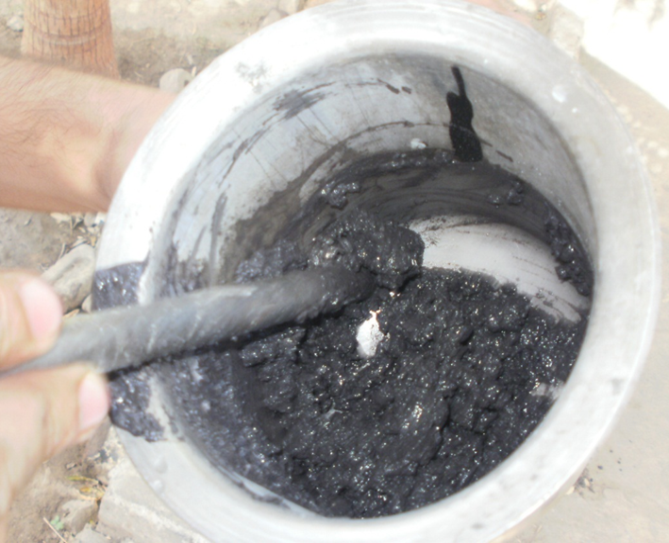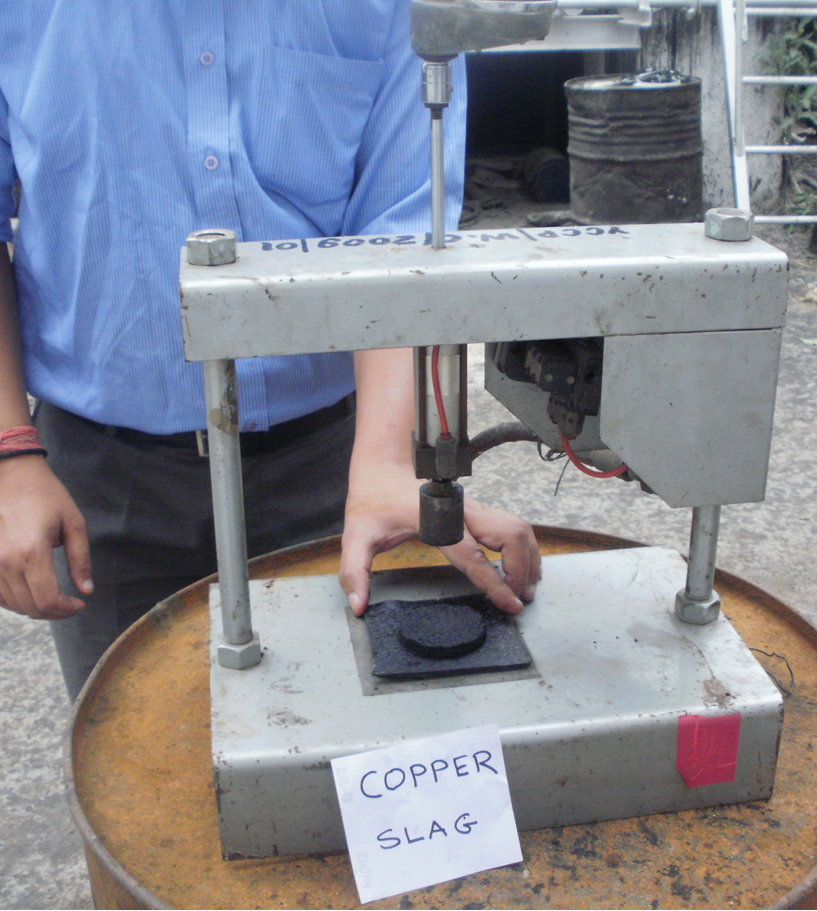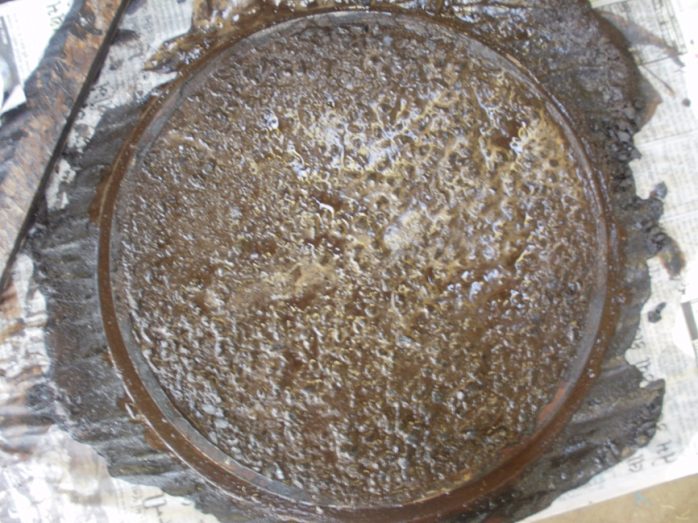Rajesh S. Gujar1, Krupesh A. chauhan2
1Research Scholar, SVNIT, Surat, Gujarat India,
2Associate Professor SVNIT, Surat, Gujarat, India
Correspondence to: Rajesh S. Gujar, Research Scholar, SVNIT, Surat, Gujarat India,.
| Email: |  |
Copyright © 2012 Scientific & Academic Publishing. All Rights Reserved.
Abstract
India is a major rice producing country, and the husk generated during milling is mostly used as a fuel in the boilers for processing paddy, producing energy through direct combustion and / or by gasification. This Rice Husk Ash (RHA) is a great environment threat causing damage to the land and the surrounding area in which it is dumped. In this research suitability analysis is done for use of Rice Husk Ash as alternative filler for an option of cement in Microsurfacing comprises of Type III Aggregate. Microsurfacing is a one of the preventive maintenance technique for highways extensively used, in India. This paper presents the results obtained from experimental investigation of optimum microsurfacing mix comprises of alternative filler as rice husk ash as a substitute of OPC. In this experimental investigation breaking time of the emulsion, the cohesion and the abrasion resistance of microsurfacing mix with rice husk ash as filler is studied. The outcomes show that rice husk ash can Provide satisfactory results for microsurfacing mix incorporating type III Aggregate.
Keywords:
Microsurfacing, Preventive Maintenance, Rice Husk Ash, Waste Utilization
Cite this paper: Rajesh S. Gujar, Krupesh A. chauhan, Feasibility of Rice Husk Ash as Optional Mineral Filler in Microsurfacing incorporating Type III Aggregate, American Journal of Environmental Engineering, Vol. 3 No. 2, 2013, pp. 95-99. doi: 10.5923/j.ajee.20130302.02.
1. Introduction
Rice milling generates a byproduct know as husk. During milling of paddy about 78 % of weight is received as rice, broken rice and bran .Rest 22 % of the weight of paddy is received as husk. This husk is used as fuel in the rice mills to generate steam for the parboiling process[10]. This husk contains about 75 % organic volatile matter and the balance 25 % of the weight of this husk is converted into ash during the firing process, is known as rice husk ash (RHA).Microsurfacing is a mixture of a polymer modified asphalt emulsion, medium to fine graded high quality aggregate, filler, additives, and water [TAC 97]. It is placed using special equipment in layers ranging inthickness from 8 to 10 mm [9]. Microsurfacing can extend service life of the pavement up to 7 to 9 years. However despite the price tag, microsurfacing is viewed as a cost effective maintenance treatment as long as the pavement deterioration (roughness and surface distress) are well above minimum thresholds. An additional benefit is that it can help with other pavement surface issues such as rutting or other deficiencies in addition to providing a new riding surface and increased friction to reduce susceptibility of accidents in Rainey season[11].The components are proportioned and blended at the rear end of a microsurfacing paver and distributed on the paver with a heavy duty "spreader box" equipped with augers and adjustable strike-off [10]. The use of microsurfacing is rapidly growing for maintenance of highways, high traffic streets and airports. Microsurfacing is normally specified and designed According to IRC: SP: 81-2008, ASTM or ISSA recommendations. In present scenario cement is used as mineral filler in mix design of microsurfacing. It enhance the breaking time of the modified asphalt emulsion and also work as filler. In this paper out comes obtained by substituting OPC by rice huskies used to improve microsurfacing Technology.The main objective of our research is to determine need of research and practices of microsurfacing worldwide, a literature review of technical documents on the subject at the national and international level and a survey of industry and agencies using micro-surfacing systems in India. This research is carried out to evaluate feasibility of rice husk ash in place of cement in Microsurfacing. Rice husk ash is selected as alternative filler on the basis of Chemical analysis, local availability, environmental effectively and economic viability. In this work my target is to design a suitable mix design for field application using alternative fillers on the basis of Experimental Investigation.
2. Material
Microsurfacing is a mixture of dense graded aggregate, asphalt emulsion, water, additive and mineral fillers. Aggregates are selected based on their gradation limit (Type II or Type III). Selection of alternative mineral filler is done based on local availability, environmental affectivity and economic viability. Fast-setting cationic emulation is selected by following IRC guidelines. Step1. Determination of Chemical and Physical Properties of materials used in microsurfacing mixStep2. Chemical and physical properties of all materials are determined in controlled environment conditions. Step3. Laboratory assessment of microsurfacing mix incorporating alternative fillerStep4. In Laboratory assessment, Mixing time, set time, Wet Cohesion (30 min and 60 min), wet stripping and weight loss by wet track abrasion test is determined for microsurfacing mix (Type II and Type III).Based on laboratory assessment microsurfacing mix design is prepared.
2.1. Aggregate
| Table 1. Physical Properties of the Aggregate |
| | Sample Type | Test Name | | Stone Aggregate Type III | Water Absorption | Sand Equivalent Value | Soundness (With sodium sulphate solution) | | 1.2 | 69.12 | *Not Required | | Test Method | IS 2386 Part 3 | IS 2720 Part 37 | IS 2386 Part 5 | | Limit as per IRC: SP: 81:2008 | Max. 2 | Min. 50 | Max. 12 |
|
|
Type II and III aggregates are generally used in microsurfacing. Type II aggregates are used for urban streets, runways, scratch and leveling courses whereas Type III aggregates are used for primary and interstate routes, wheel ruts, scratch and leveling courses. Type II is finer than Type III. In this research type III aggregates were used for in microsurfacing mix. The Source of aggregates was Ramakrishna Stone Crusher Sail Gujarat, India. Physical properties of aggregates like water absorption, Sand equivalent Value and Soundness is determined using IS 2386 Part 3, IS 2720 Part 37 and IS 2386 Part 5 respectively at 25℃ temperature. The required physical properties of the aggregate are presented in table 1.The gradation of the aggregate mixture was within the specified limits as determined by IRC:SP:81-2008 for Type III mixture. The actual gradation of the aggregate mixture is as shown in Fig. 1. | Figure 1. IRC: SP: 81-2008 Type III Gradation |
2.2. Bitumen Emulsion
The bitumen emulsion used was a cationic bitumen emulsion modified with latex. The Source of Polymer Modified Emulsion is Tiki Tar Industries (Baroda) Limited Its characteristics, which meet the requirements IRC:SP:81-2008 specification, are shown in Table 2. In the laboratory analysis of bitumen emulation characteristics properties like Residue on 600 micron IS Sieve (% by mass), Viscosity by Say Bolt Furol Viscometer, at 25o C, in second, Coagulation of emulsion at low temperature and Storage Stability after 24h is determined using IS: 8887 at 25℃ Temperature.Table 2. Characteristic properties of polymer modified bitumen emulsion
 |
| |
|
2.3. Mineral Fillers
ThemineralfillersusedwereordinaryPortlandcement(OPC)andrice husk ash.The composition of the ordinary Portland cement is shown in table 4. Rice Husk Ash was collected from Rice processing mill Bvala, Dist Ahmedabad, Gujrat This RHA in turn contains around 85%-90% amorphous silica. Table 3 shows the chemical composition of rice husk ash. | Table 3a. Composition of Rice Husk Ash |
| | PARAMETER | UNIT | Resultsobtained | | SiO2 | % | 80.2 | | Al2O3 | % | 0.14 | | Fe2O3 | % | 0.1 | | Reactive Slice | % | 18.1 | | MgO | % | 0.23 | | SO3 | % | 0.26 | | Na2O | % | 0.37 | | Cl2 | % | 0.17 | | Loss of Ing. | % | 4.7 | | CaO | % | 0.55 | | Phosphorous (P2O5) | % | 0.35 | | Potassium (K2O) | % | 1.3 | | PH | % | 8.9 |
|
|
| Table 3b. Chemical composition of ordinary Portland cement |
| | PARAMETER | UNIT | Test MethodStandard | ResultsObtained | | SiO2 | % | IS : 4032 | 18.2 | | Al2O3 | % | IS : 4032 | 4.1 | | Fe2O3 | % | IS : 4032 | 4.6 | | Reactive Slice | % | IS : 4032 | | | MgO | % | IS : 4032 | 2.9 | | SO3 | % | IS : 4032 | 1.9 | | Cl2 | % | IS : 4032 | 0.04 | | Loss of Ing. | % | IS : 4032 | 2.9 | | CaO | % | IS : 4032 | 54.2 | | 2C3A+C4AF | % | IS : 4032 | 22.6 | | C3A | % | IS : 4032 | 4.2 | | C4AF | % | IS : 4032 | 14.2 | | INSOLUBLE RESIDUE | % | IS : 4032 | 2.1 | | Al2O3/ Fe2O3 | % | IS : 4032 | 0.89 |
|
|
3. Laboratory Investigation
To examine suitability of every trial mix following test are performed:
3.1. Manual Mixing Test
100 g or 200 g samples of aggregate are hand-mixed with first filler, then water (Optionally containing control additive) then emulsion. After 30 seconds part of the mix is poured out and the remainder is stirred until the emulsion breaks (‘mix time’). The poured-out sample is checked for clear water exuding by patting with filter paper. When the water is clear this gives the approximate ‘set time’. Mix times in the range of 30-180 seconds may be acceptable depending on the type of paver used. Handwork may require longer mix times. | Figure 2. Manual mixing test of microsurfacing mix |
3.2. Cohesion Test
This unit is used to measure cure rates of slurries and microsurfacing[3]. This is critical in design of mixes and is a part of the standard specification of most authorities including the International Slurry Surfacing Association. It is essential for ASTM D-3910 testing, IRC: SP: 81-2008 specifications and ISSA TB 139. | Figure 3. Cohesion Test of microsurfacing mix |
3.3. Wet Track Abrasion Test (WTAT)
A circular test specimen of slurry is prepared with a special mould and, when fully cured, is soaked by immersion in water for a specified period, usually 1 hour or 6 days. Then it is subjected to abrasion under water by a weighted rubber hose mounted on a planetary mixer. The weight loss is a measure of the durability of the surface. The standard test involves curing at 60℃ (140°F) but modified tests involving room temperature curing may be specified by some authorities. | Figure 4. Wet track abrasion test of microsurfacing mix |
Laboratory Evaluation is done to determine the optimum combination of incorporating materials of microsurfacing mix to get effective results at the time of application of microsurfacing on field.in our study Type III aggregates are taken in to consideration. The difference between type II and Type III is only variation of gradation. Type II is finer then as of type II aggregate. Laboratory evaluation is done by varying proportion of microsurfacing. The microsurfacing mix comprises of type III aggregates were tested for the determination of Mix Time, Consistency, Cohesion, Wet Stripping, Wet Track Abrasion loss,accordingtoIRC: SP: 81-2008 specifications. Based on laboratory investigation microsurfacing mix proportion is designed according to IRC: SP: 81-2008 specifications. Based on the sieve analysis result and others recommended criteria mentioned in IRC: SP: 81-2008 the material are mixed in the proportions shown in table 4.The mixing is done at temperature of 25℃. A result obtained from Laboratory Investigation of microsurfacing designed mix is presented in Table 5.| Table 4. Mix Design of Microsurfacing Mix |
| | MATERIAL | MIX PROPORTIONS (%) | | Aggregates | 100 | | fillers | 2 % of aggregate | | Water | 12 % of aggregate | | Polymer Modified Emulsion | 13.0 % of aggregate | | Additive | 2.5% of aggregate |
|
|
4. Results and Discussion
The results obtained from the use of Rice husk ash optional fillers in microsurfacing mix comprises of type III aggregates are showed in Table 5. Mixing time obtained in rice husk ash is higher than that of cement which indicate that microsurfacing with Rice husk ash can be applied in the region having low temperature. As it can be seen that rice husk ash gave results under the specified limits of IRC: SP: 81-2008 except abrasion loss. Experimental investigation shows that potential of rice husk as alternative filler is lower than that of cement so it is only used in low traffic volume roads.| Table 5. Results obtained from experimental investigation |
| | Requirement/Test names | Cement | Rice Husk | Limits as per IRC:SP:81-2008 | | Mix Time (seconds) | 122 | 149 | 120s Minimum | | Consistency (cm) | 2.4 | 2.9 | 3cm, Max | | Wet Cohesion, 30min; (kg.cm) | 14 | 8 | 12 kg.cm Min | | Wet Cohesion, 60min; (kg.cm) | 22 | 20.9 | 20 kg.cm Min | | Wet Stripping, Pass% | 97 | 98.1 | 90 Min | | Wet Track Abrasion loss,(one hour soak); g/m2 | 347.29 | 619.5 | 538 g/m2Max |
|
|
5. Conclusions
The use of Microsurfacing in India becomes famous in last few years in the field of highway maintenance and pavement improvement. Till now, OPC is used for making microsurfacing mix comprises of type III aggregates, as filler due to its good mixing purposes and adhesion. In this research Rice Husk ash is used as optional fillers in order to substitute cement in the production of microsurfacing. Rice husk as an optional filler should not be used for production of microsurfacing mix for high traffic volume roads due to its high abrasion loss and lower specific gravity which leads to improper mixing. The use of rice husk ash reduces the cost of microsurfacing but not improve the quality of microsurfacing mix so it not advisable to use rice husk ash as alternative filler microsurfacing mix incorporating Type III aggregates which is used for primary and interstate routes, wheel ruts, scratch and levelling courses. Nevertheless we can use rice husk ash with cement to improve the preventive maintenance measures.
References
| [1] | N. Oikonomou. (2007). Alternative Fillers For Use In Slurry Seal. Global NEST Journal. 9 (2), 182-186. |
| [2] | IRC: SP: 81-2008Tentative Specification for SlurrySeal and MicrosurfacingNikolaides. (2000). The use of flyash as a substitute of cement in microsurfacing. WasteMaterials in Construction, p234-240. |
| [3] | ASTMD3910-90,Design,TestingandConstructionofSlurrySeal,AnnualBookofASTMStandards,Section4,Construction,Vol.04.03,RoadandPavingMaterial(1996) |
| [4] | InternationalSlurrySurfacingAssociation,RecommendedPerformanceGuidelinesforMicrosurfacing,ISSA,A143,,Washington D.C.(1991) |
| [5] | AASHTOM316-96,PolymerModifiedCationicEmulsifiedAsphalt,Standard |
| [6] | SpecificationsforTransportationMaterialsandMethodsofSamplingandTesting,PartI, Specifications(1998) |
| [7] | Ricehuskash,http://www.ricehuskash.com/details.htm |
| [8] | BipraG. (2003). Characteristics and utilisation of copperslag—a review. Resources, Conservation and Recycling. 39 (4), P299-313.] |
| [9] | Gujar R. et. al. (2012) application of hydrated limeas optional filler inmicrosurfacing, IJCIET, Volume 3, Issue 2, July- December (2012), pp. 207-213 |
| [10] | Nagrale S. D.et. al. (2012), Utilization Of Rice Husk Ash, Vol. 2, Issue 4, July-August 2012, pp.001-005 |
| [11] | Gujar R. et. al. (2012) Application Of Copper Slagas Optional Filler In MicrosurfacingInternational Journal of CivilEngineering (IJCE) Vol.1, Issue 2 Nov 2012 |





 Abstract
Abstract Reference
Reference Full-Text PDF
Full-Text PDF Full-text HTML
Full-text HTML